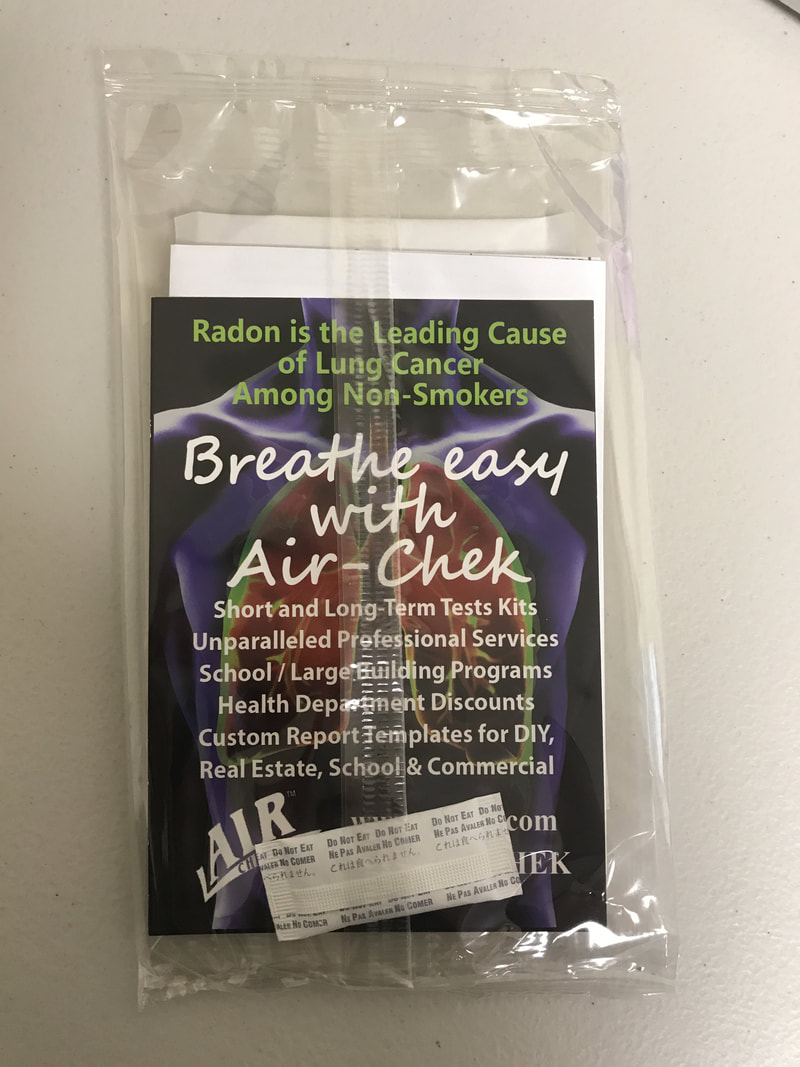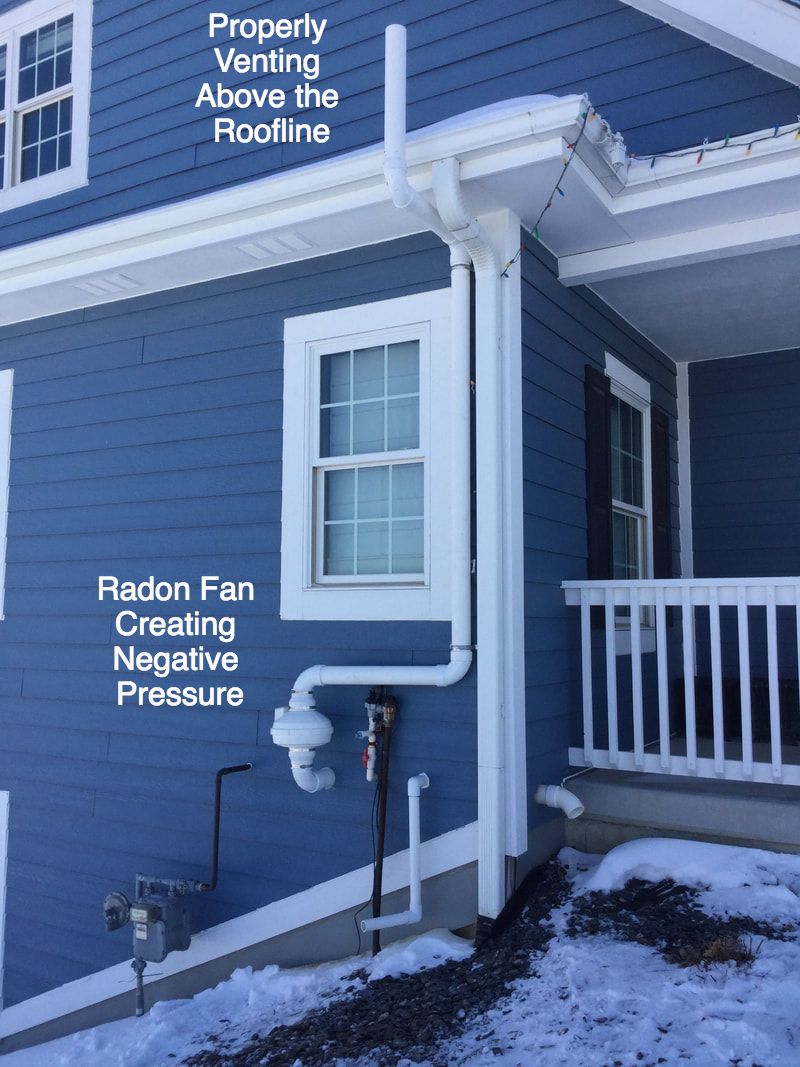What is Radon?Radon is what is known as a soil gas. It is caused by the breakdown of uranium decay products in the soil. A popular misconception is that only certain areas or specific places have radon when in reality there is a certain amount of radon in the air you breathe whether you are inside or outside. The average outdoor air concentrations of radon gas in the United States are between 0.4 and 0.7 pCi/L. On the other hand, the average indoor radon level in the United States is right around 1.7 pCi/L. The EPA has set an action level of 4.0 pCi/L, meaning if your indoor levels are at 4.0 pCi/L or above, they highly recommend that you mitigate your home or commercial structure. The reason an action level is set is because radon gas exposure is the 2nd leading cause of lung cancer overall and the #1 cause of lung cancer in non-smokers. Moreover, the EPA and Surgeon General estimate that around 21,000-25,000 people die each year from radon related lung cancer. Additionally, radon is considered to be a class A carcinogen. This means, validated scientific studies have shown that prolonged exposure to radon gas can cause cancer in humans. Interestingly enough, the World Health Organization sets their action level at 2.7 pCi/L. Therefore, in recent years the EPA has somewhat updated their wording on this topic and suggested that if your indoor, average levels are between 2.0 and 3.9 pCi/L you should consider radon mitigation for the living space. However, they still maintain that the EPA action level is 4.0 pCi/L here in the United States. Radon TestingAs previously mentioned, radon is a soil gas that is present in the air virtually everywhere around us. Unfortunately, for many, radon is pretty difficult to comprehend because you cannot see it, taste it, touch it or smell it. There are no distinct signs or signals that tell you or alert you that you may have a radon problem. Because of this reason, it is important to test your home for radon gas. Radon testing is the only sure way to know if you have a radon problem within your home or commercial property. Furthermore, because radon is everywhere, the EPA recommends no matter where you live, you should test your home for elevated levels of radon gas. In fact, because homes are constantly settling, the Earth consistently shifting and the like, the EPA highly suggests that you test your property every 2 years. Many times, you can find special promotions or offers on radon testing from radon mitigation companies during National Radon Action Month (January) or from local community service organizations and municipalities. Even still, there are many different options available for radon testing and those options, without special discounts, generally range from around $25 to $150. A small price to pay to avoid the major costs and suffering associated with lung cancer. Radon MitigationIf your indoor radon test does come back high (above 4.0 pCi/L) the EPA highly suggests that you mitigate your home or commercial property. Radon mitigation is the process of reducing the indoor radon levels of a structure. For more information on radon mitigation systems, check out our radon mitigation system blog post. Radon mitigation is most often times performed by active soil depressurization, however, in some more rare instances, radon mitigation can be performed by pressurization or air exchange. In addition to indoor air quality, radon mitigation can be performed on a private well to reduce radon levels within the private water system. This too is a bit more rare than the radon mitigation done to reduce the average radon levels in the air of a home or commercial structure. How does Radon Mitigation Actually Work?The easiest way to explain radon mitigation and how it works is to begin explaining the pressure differential between a house or commercial structure and the soil that it sits on. The pressure in the structure is different than the pressure in the soil beneath the structure and the wind, the temperature, the barometric pressure systems, etc. all push and pull on that property, consistently changing the pressure between the property and the soil. This means, in certain instances, the negative pressure of the home is actually drawing soil gasses into the living envelope more drastically than other times and because the living space is confined, radon levels have a chance to grow in higher concentration. Negative pressure differentials can also be caused by a number of different things like exhaust fans, stack effect and many other factors depending on home construction and region.
Radon technicians perform radon mitigation by using specifically designed radon mitigation fans and PVC pipe to create negative pressure under the slab, ultimately drawing the radon out, and venting it safely and properly above the roofline. In order to create negative pressure under the slab it is extremely important that all the cracks are sealed, the floor to wall joints are sealed, and the sump crock is sealed as well. This will help ensure that good suction and field extension can occur while depressurizing the slab. It also helps to ensure the radon fan is not responsible for any backdrafting of mid-efficiency appliances and their combustible gasses. By depressurizing the slab, the radon is now drawn into the piping rather than into the home in higher concentrations. Every home is different and therefore the pressure differential in every home is different as well. This is why it is important for a radon mitigation professional to evaluate your specific situation by discussing with you what type of structure you have (basement, crawlspaces, slab on grade, etc.), whether you have a drain-tile or sump pump system, whether your home has exposed dirt or gravel crawlspaces, and many other factors that may play into why and how the radon is entering in the first place. In some cases, homes and commercial properties may require advanced diagnostic testing to determine air flow, field extension, and other factors that may play into the success of the radon mitigation process. Once the potential source of the radon issue and the construction of the property is discussed or tested, the radon mitigation technician will know how to properly seal your slab, how to cover the most area under the slab in regards to suction, and the appropriate system design and fan model to use while doing so. Because radon gas is everywhere, it is nearly impossible to get your indoor radon levels down to 0.0 pCi/L. However, many times radon mitigation can get indoor radon levels below 1.0 pCi/L (which is around outdoor air quality) and most of the time, radon mitigation will get the indoor radon levels below 2.0 pCi/L. In the end, this is a very brief synopsis or snapshot of how radon mitigation works and what radon mitigation is. If you would like to lean more about radon mitigation and how one could properly mitigate your living space, please call or email us below. Our radon mitigation technicians have more than 30 years of combined experience and with more than 10,000 installations under our belts, we have seen and mitigated just about everything!
6 Comments
Types of Radon Mitigation SystemsThe basic concept of radon mitigation is to reduce the levels of radon gas within a structure. There are a few approaches to radon mitigation, but one approach far surpasses the others in terms of overall cost, effectiveness, and addressing the radon issue before it enters the structure in the first place. This concept is known as active soil depressurization. Active soil depressurization is the idea that by sealing the slab and creating a vacuum underneath the basement floor, one can use a special radon mitigation fan to create negative pressure throughout the sub-soil and ultimately draw the soil gas from beneath the home or building to safely vent it above the roofline. This method is preferred because it stops the radon before it enters the home and decays into what is known as radon prodigy. The radon decay products are especially harmful because they stick to particles in the air and are ultimately ingested into the lungs. Therefore, by utilizing active soil depressurization, one can redirect the vast majority of the radon before it enters the home in higher concentrations and ultimately decays into cancer causing alpha particles. Types of Active Soil DepressurizationSub-slab Depressurization SystemsSub-slab depressurization is an extremely common way of installing a radon mitigation system. A sub-slab depressurization system is a type of active soil depressurization system that requires the radon technician to dig what is known as a suction point or collection pit under the slab. Many newer homes have sump pump systems and drain-tile systems that allow for increased field extension under the slab of the home. However, when homes are older, or if they do not have a drain-tile system, the radon mitigation technician will have to dig a pit under the slab to help create a means for good airflow under the sealed floor. The specialized radon fans then pull air through the soil surrounding the collection point and ultimately soil gases and moisture are reduced. Interestingly enough, because the fan is constantly running and radon fans remove a lot of moisture from beneath the slab, the radon mitigation system will dry out the sub-soil and create cracks and crevices in the sub-slab material that will drastically help in drawing the radon from areas further away from the collection point. Furthermore, radon mitigation systems in general, but particularly sub-slab depressurization systems, are many times used as moisture reduction systems because they help reduce moisture before it enters into the home as well. Drain-tile Depressurization SystemsAs eluded to earlier, drain-tile depressurization is an extremely successful way of creating active soil depressurization. Because the drain-tile piping is open to the soil and travels near the footing, all the way around the interior walls of the basement, one can utilize this system to pull air through the soil nearly everywhere under the basement slab. In addition, because radon gas always finds the path of least resistance, many times radon will fill the open voids of the drainage system because the soil around it is so tightly compact. Therefore, by utilizing this sub-slab drainage system as a means to collect and remediate radon, one can effectively reduce radon levels substantially.
Another way you can utilize drain-tile depressurization as a means of radon mitigation is through sump-pit depressurization. As you might see, the common theme in the radon mitigation process is to depressurize the slab. Radon technicians will sometimes use the sump pump pit as a collection point because it is directly connected to the drain-tile system, which will of course create phenomenal field extension throughout the sub-slab material. The examples above are just a few of the common types of radon mitigation systems used today. To hear more about the dangers of radon gas exposure, to test your home, or to ask more questions about what type of radon mitigation system is right for your home, contact our courteous and certified staff today. We have been in business for more than 20 years, we mitigate thousands of homes annually, and we have never run into a situation where we weren't able to mitigate the property under the EPA action level of 4.0 pCi/L. When it comes to your health, your home and your family, why risk it? |
AuthorRadon System Solutions ArchivesCategories |
- Home
-
Locations
- Madison
- Beloit/Janesville
- Kenosha
- Twin Cities
- Minneapolis
- St. Paul
- Sheboygan
- Appleton
- Green Bay
-
All Locations
>
- Radon Mitigation Afton
- Radon Mitigation Amherst
- Radon Mitigation Amherst Junction
- Radon Mitigation Butler
- Radon Mitigation Walworth
- Radon Mitigation Deerfield
- Radon Mitigation Sturtevant
- Radon Mitigation Marshall
- Radon Mitigation Windsor
- Radon Mitigation Mayville
- Radon Mitigation Chilton
- Radon Mitigation Howards Grove
- Radon Mitigation Brillion
- Radon Mitigation Omro
- Radon Mitigation Columbus
- Radon Mitigation Edgerton
- Radon Mitigation Palmyra
- Radon Mitigation New Holstein
- Radon Mitigation Adell
- Radon Mitigation Albany
- Radon Mitigation Allenton
- Radon Mitigation Arlington
- Radon Mitigation Ashippun
- Radon Mitigation Avalon
- Radon Mitigation Belleville
- Radon Mitigation Belgium
- Radon Mitigation Berlin
- Radon Mitigation Big Bend
- Radon Mitigation Whitelaw
- Radon Mitigation Lannon
- Radon Mitigation Lomira
- Radon Mitigation Elm Grove
- Radon Mitigation East Troy
- Radon Mitigation Elkhorn
- Radon Mitigation Eagle
- Radon Mitigation Evansville
- Radon Mitigation Oostburg
- Radon Mitigation Johnson Creek
- Radon Mitigation Muskego
- Radon Mitigation Union Grove
- Radon Mitigation Kewaskum
- Radon Mitigation Hustisford
- Radon Mitigation Hales Corners
- Radon Mitigation North Prairie
- Radon Mitigation Elkhart Lake
- Radon Mitigation Trevor
- Radon Mitigation Burnett
- Radon Mitigation Lake Geneva
- Radon Mitigation Delavan
- Radon Mitigation Williams Bay
- Radon Mitigation Beaver Dam
- Radon Mitigation Arena
- Radon Mitigation Baraboo
- Radon Mitigation Barneveld
- Radon Mitigation Bassett
- Radon Mitigation Beloit
- Radon Mitigation Blanchardville
- Radon Mitigation Black Earth
- Radon Mitigation Benet Lake
- Radon Mitigation Black Creek
- Radon Mitigation Blue Mounds
- Radon Mitigation Branch
- Radon Mitigation Brandon
- Radon Mitigation Brodhead
- Radon Mitigation Brookfield
- Radon Mitigation Brooklyn
- Radon Mitigation Brownsville
- Radon Mitigation Burlington
- Radon Mitigation Burnett
- Radon Mitigation Bristol
- Radon Mitigation Byron
- Radon Mitigation Caledonia
- Radon Mitigation Cambria
- Radon Mitigation Cambridge
- Radon Mitigation Camp Lake
- Radon Mitigation Campbellsport
- Radon Mitigation Cascade
- Radon Mitigation Cedar Grove
- Radon Mitigation Cedarburg
- Radon Mitigation Cleveland
- Radon Mitigation Clinton
- Radon Mitigation Clyman
- Radon Mitigation Colgate
- Radon Mitigation Combined Locks
- Radon Mitigation Cottage Grove
- Radon Mitigation Cudahy
- Radon Mitigation Dale
- Radon Mitigation Dane
- Radon Mitigation Darien
- Radon Mitigation DeForest
- Radon Mitigation De Pere
- Radon Mitigation Delafield
- Radon Mitigation Dousman
- Radon Mitigation Doylestown
- Radon Mitigation Eden
- Radon Mitigation Eldorado
- Radon Mitigation Eureka
- Radon Mitigation Fairwater
- Radon Mitigation Fall River
- Radon Mitigation Fond du Lac
- Radon Mitigation Fontana
- Radon Mitigation Footville
- Radon Mitigation Forest Junction
- Radon Mitigation Fort Atkinson
- Radon Mitigation Friesland
- Radon Mitigation Franklin
- Radon Mitigation Franksville
- Radon Mitigation Fredonia
- Radon Mitigation Freedom
- Radon Mitigation Fremont
- Radon Mitigation Fox Lake
- Radon Mitigation Genesee Depot
- Radon Mitigation Genoa City
- Radon Mitigation Germantown
- Radon Mitigation Glenbeulah
- Radon Mitigation Grafton
- Radon Mitigation Green Lake
- Radon Mitigation Greenbush
- Radon Mitigation Greendale
- Radon Mitigation Greenleaf
- Radon Mitigation Greenville
- Radon Mitigation Hartford
- Radon Mitigation Hartland
- Radon Mitigation Helenville
- Radon Mitigation Hilbert
- Radon Mitigation Hingham
- Radon Mitigation Horicon
- Radon Mitigation Hortonville
- Radon Mitigation Hubertus
- Radon Mitigation Iron Ridge
- Radon Mitigation Ixonia
- Radon Mitigation Jackson
- Radon Mitigation Jefferson
- Radon Mitigation Kaukauna
- Radon Mitigation Juneau
- Radon Mitigation Kansasville
- Radon Mitigation Kiel
- Radon Mitigation Kimberly
- Radon Mitigation King
- Radon Mitigation Kohler
- Radon Mitigation Lake Mills
- Radon Mitigation Larsen
- Radon Mitigation Lebanon
- Radon Mitigation Little Chute
- Radon Mitigation Lodi
- Radon Mitigation Lowell
- Radon Mitigation Lyons
- Radon Mitigation Malone
- Radon Mitigation Manawa
- Radon Mitigation Manitowoc
- Radon Mitigation Markesan
- Radon Mitigation Marquette
- Radon Mitigation Mazomanie
- Radon Mitigation McFarland
- Radon Mitigation Menasha
- Radon Mitigation Mequon
- Radon Mitigation Menomonee Falls
- Radon Mitigation Merrimac
- Radon Mitigation Merton
- Radon Mitigation Middleton
- Radon Mitigation Milton
- Radon Mitigation Milwaukee
- Radon Mitigation Mishicot
- Radon Mitigation Monticello
- Radon Mitigation Mount Calvary
- Radon Mitigation Mount Horeb
- Radon Mitigation Mukwonago
- Radon Mitigation Nashotah
- Radon Mitigation Neenah
- Radon Mitigation Neosho
- Radon Mitigation New Berlin
- Radon Mitigation New Glarus
- Radon Mitigation New London
- Radon Mitigation New Munster
- Radon Mitigation Newburg
- Radon Mitigation Newton
- Radon Mitigation North Lake
- Radon Mitigation Oak Creek
- Radon Mitigation Oregon
- Radon Mitigation Orfordville
- Radon Mitigation Oshkosh
- Radon Mitigation Pardeeville
- Radon Mitigation Pewaukee
- Radon Mitigation Pickett
- Radon Mitigation Pleasant Prairie
- Radon Mitigation Plymouth
- Radon Mitigation Port Washington
- Radon Mitigation Portage
- Radon Mitigation Potter
- Radon Mitigation Poynette
- Radon Mitigation Prairie Du Sac
- Radon Mitigation Racine
- Radon Mitigation Randolph
- Radon Mitigation Random Lake
- Radon Mitigation Reedsville
- Radon Mitigation Reeseville
- Radon Mitigation Richfield
- Radon Mitigation Rio
- Radon Mitigation Ripon
- Radon Mitigation Rochester
- Radon Mitigation Rosendale
- Radon Mitigation Rubicon
- Radon Mitigation St. Cloud
- Radon Mitigation Saint Francis
- Radon Mitigation Saint Nazianz
- Radon Mitigation Salem Lakes
- Radon Mitigation Sauk City
- Radon Mitigation Saukville
- Radon Mitigation Scandinavia
- Radon Mitigation Sharon
- Radon Mitigation Sheboygan Falls
- Radon Mitigation Sherwood
- Radon Mitigation Shiocton
- Radon Mitigation Slinger
- Radon Mitigation Somers
- Radon Mitigation South Milwaukee
- Radon Mitigation Stockbridge
- Radon Mitigation Stoughton
- Radon Mitigation Sullivan
- Radon Mitigation Summit
- Radon Mitigation Sun Prairie
- Radon Mitigation Sussex
- Radon Mitigation Theresa
- Radon Mitigation Thiensville
- Radon Mitigation Twin Lakes
- Radon Mitigation Two Rivers
- Radon Mitigation Valders
- Radon Mitigation Van Dyne
- Radon Mitigation Verona
- Radon Mitigation Waldo
- Radon Mitigation Wales
- Radon Mitigation Waterford
- Radon Mitigation Waterloo
- Radon Mitigation Watertown
- Radon Mitigation Waukau
- Radon Mitigation Waukesha
- Radon Mitigation Waunakee
- Radon Mitigation Waupaca
- Radon Mitigation Waupun
- Radon Mitigation West Bend
- Radon Mitigation Weyauwega
- Radon Mitigation Whitewater
- Radon Mitigation Winneconne
- Radon Mitigation Woodland
- Radon Mitigation Wrightstown
- Radon Mitigation Wyocena
- Radon Mitigation Zenda
- Services
- Resources
- Contact Us
- Blog




 RSS Feed
RSS Feed
